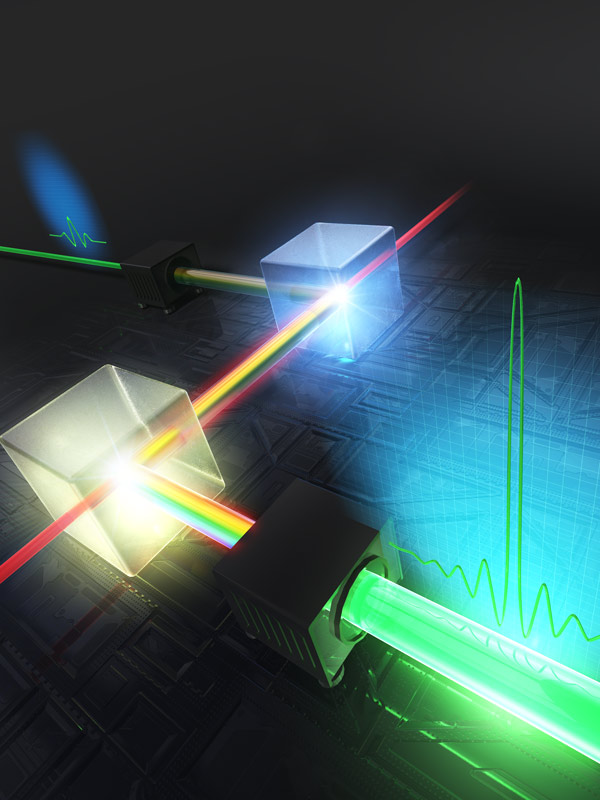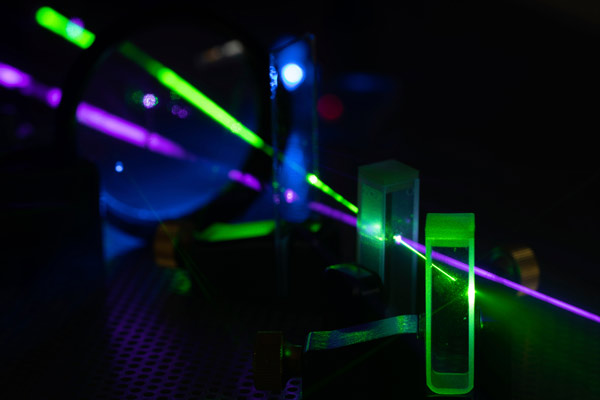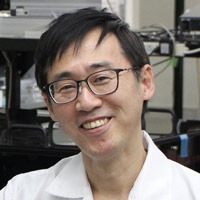
A new technique, called advanced dual-chirped optical parametric amplification, has increased the energy of single-cycle laser pulses by a factor of 50. The technique uses two crystals (shown as clear cubes), which amplify complementary regions of the spectrum. © 2024 RIKEN
Extremely short pulses of laser light with a peak power of 6 terawatts (6 trillion watts)-roughly equivalent to the power produced by 6,000 nuclear power plants-have been realized by two RIKEN physicists1. This achievement will help further develop attosecond lasers, for which three researchers were awarded the Nobel Prize in Physics in 2023.
In the same way that a camera flash can 'freeze' rapidly moving objects, making them appear as if they are standing still in photos, extremely short laser pulses can help light up ultrafast processes, providing scientists with a powerful way to image and probe them.
For example, laser pulses of the order of attoseconds (one attosecond = 10-18 second) are so short that they can reveal the motion of electrons in atoms and molecules, giving a new way to discover how chemical and biochemical reactions evolve. Even light seems to crawl at such short time scales, taking about 3 attoseconds to traverse a single nanometer.
"By making it possible to capture the motion of electrons, attosecond lasers have made a major contribution to basic science," says Eiji Takahashi of the RIKEN Center for Advanced Photonics (RAP). "They're expected to be used in a wide range of fields, including observing biological cells, developing new materials and diagnosing medical conditions."
Power and punch
But while it is possible to create ultrashort laser pulses, they lack much punch, having low energies. Creating laser pulses that are both ultrashort and have high energies would greatly expand their possible uses. "The current output energy of attosecond lasers is extremely low," says Takahashi. "So it's vital to increase their output energy if they are to be used as light sources in a wide range of fields."
Just as audio amplifiers are used to boost sound signals, laser physicists use optical amplifiers to increase the energy of laser pulses. These amplifiers usually employ nonlinear crystals that exhibit special responses to light. But these crystals can be irreparably damaged if they are used to amplify single-cycle lasers pulses, which are so short that the pulse finishes before the light can oscillate through a full wavelength cycle.
"The biggest bottleneck in the development of energetic, ultrafast infrared laser sources has been the lack of an effective method to directly amplify single-cycle laser pulses," explains Takahashi. "This bottleneck has resulted in a one-millijoule barrier for the energy of single-cycle laser pulses."

Eiji Takahashi and RAP colleague, Lu Xu have made a breakthrough in high-energy ultrafast lasers. © WILLIAM BULGAR/SCIENCE PHOTO LIBRARY/Getty
A new record
Now, Takahashi and RAP colleague, Lu Xu, have not just exceeded this barrier, they have smashed through it. They have amplified single-cycle pulses to beyond 50 millijoules-more than 50 times the previous best effort. Because the resulting laser pulses are so short, this energy translates into incredibly high powers of several terawatts. "We've demonstrated how to overcome the bottleneck by establishing an effective method for amplifying a single-cycle laser pulse," says Takahashi.
Their method, called advanced dual-chirped optical parametric amplification (DC-OPA), is surprisingly simple, involving just two crystals, which amplify complementary regions of the spectrum. "Advanced DC-OPA for amplifying a single-cycle laser pulse is very simple, being based on just a combination of two kinds of nonlinear crystals-it feels like an idea that anyone could have come up with," says Takahashi. "I was surprised that such a simple concept provided a new amplification technology and caused a breakthrough in the development of high-energy ultrafast lasers."
Importantly, advanced DC-OPA works over a very broad range of wavelengths. Takahashi and Xu were able to amplify pulses whose wavelengths differed by more than a factor of two. "This new method has the revolutionary feature that the amplification bandwidth can be made ultrawide without compromising the output energy-scaling characteristics," says Takahashi.
Amplification technique
Their technique is a variation on another amplification technique for optical pulses, called 'chirped pulse amplification', for which three researchers from the United States, France and Canada were awarded the Nobel Prize in Physics in 2018. There is an interesting connection between the 2018 and 2023 prizes in that chirped pulse amplification was one of the techniques that enabled the development of attosecond lasers.
Takahashi anticipates that their technique will further advance the development of attosecond lasers. "We have succeeded in developing a new laser amplification method that can increase the intensity of single-cycle laser pulses to terawatt-class peak power," he says. "It's undoubtedly a major leap forward in the development of high-power attosecond lasers."
In the longer term, he has his sights set on going beyond attosecond lasers and creating even shorter pulses.
"By combining single-cycle lasers with higher-order nonlinear optical effects, it could well be possible to generate pulses of light with a time width of zeptoseconds (one zeptosecond = 10-21 second)," he says. "My long-term goal is to knock on the door of zeptosecond-laser research, and open up the next generation of ultrashort lasers after attosecond lasers."
Rate this article
Stars





Thank you!
Submit
Reference
- 1. Xu, L. & Takahashi, E. J. Dual-chirped optical parametric amplification of high-energy single-cycle laser pulses. Nature Photonics 18, 99-106 (2024). doi: 10.1038/s41566-023-01331-9
About the researcher
Eiji J. Takahashi

Eiji Takahashi is the team leader of the Ultrafast Coherent Soft X-ray Photonics Research Team at the RIKEN Center for Advanced Photonics, and a chief scientist at the Extreme Laser Science Laboratory at the RIKEN Cluster for Pioneering Research. He received his Ph.D. in engineering at Utsunomiya University, Utsunomiya, Japan, in 2001. After this, he worked on the early development of intense high-order harmonic sources and spectroscopy at RIKEN. In 2004, he joined the Institute for Molecular Science, a research institute near Nagoya in Japan, where he was an assistant professor. Since re-joining RIKEN in 2006, Takahashi has researched novel ultrafast laser sources, such as optical waveform synthesizers, coherent soft x-rays, and attosecond lasers. His research interests include high-intensity laser-matter interactions, attosecond science, and high-power laser technology.






